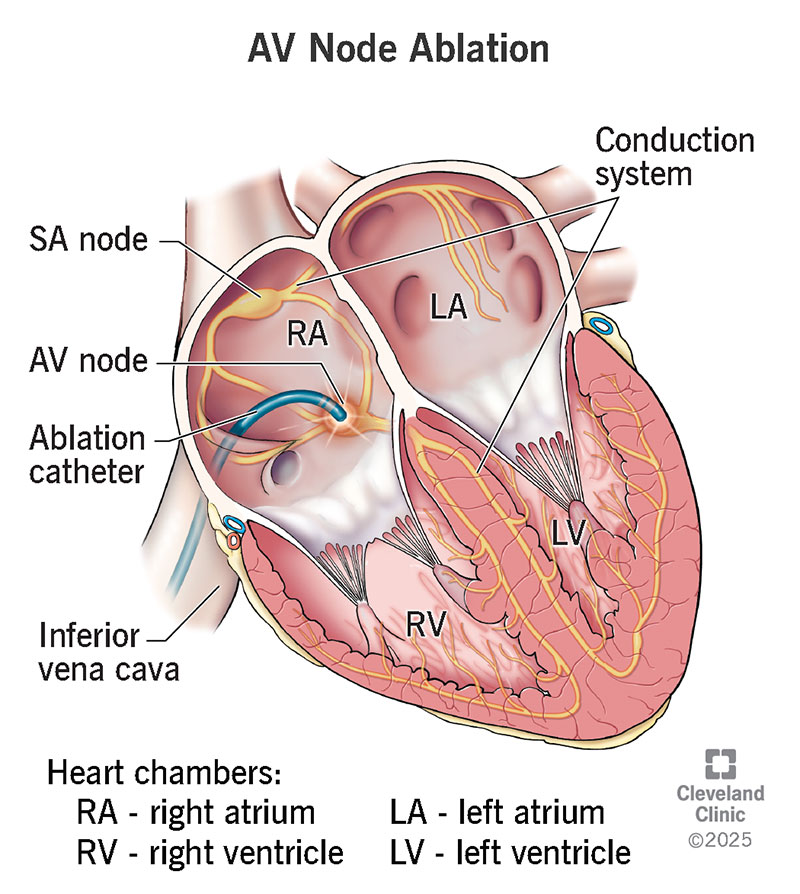AV node ablation is a minimally invasive treatment for atrial fibrillation and other issues in your heart’s upper chambers. It’s a permanent procedure that can’t be reversed, but it has a high success rate and quick recovery. People who have AV node ablation will always need pacemakers.
Advertisement
Cleveland Clinic is a non-profit academic medical center. Advertising on our site helps support our mission. We do not endorse non-Cleveland Clinic products or services. Policy

Atrioventricular (AV) node ablation is a way to treat atrial fibrillation by damaging part of your heart’s conduction system with a catheter. This minimally invasive treatment uses heat or cold energy to damage your AV node on purpose. Doing this can prevent abnormal heartbeats.
Advertisement
Cleveland Clinic is a non-profit academic medical center. Advertising on our site helps support our mission. We do not endorse non-Cleveland Clinic products or services. Policy
After an AV node ablation, you need a permanent pacemaker to take over the job of sending electrical signals to tell your heart to beat. The intent is to get your heart beating more in sync, which may improve your symptoms and your heart’s strength. Out-of-sync contraction of your atria can lead to weakness in your lower chambers and your whole heart.
The AV node is a small area of tissue that sends heartbeat signals. These signals go from your heart’s upper chambers (atria) to your lower chambers (ventricles).
AV node ablation is serious because it’s not reversible. It’s permanent. That’s why people who have it will need pacemakers for the rest of their lives.
An AV node ablation procedure treats abnormal heart rhythms that happen in your heart’s upper chambers. Besides atrial fibrillation, this includes atrial flutter and other SVTs. A healthcare provider may recommend AV node ablation when AFib is hard to manage.
AV node ablation may be an option for you if:
If you don’t already have one, you’ll need a permanent pacemaker. You may get it several weeks before your atrioventricular node ablation. Or you may get one in the same procedure or after AV node ablation.
Advertisement
Your healthcare provider will do an EP study. This allows them to map your heart’s electrical signals and find the exact location of your AV node.
The steps of AV node ablation include:
The procedure can take less than an hour to several hours.
An atrioventricular node ablation has multiple benefits, like:
Complications are rare, but may include:
After atrioventricular node ablation, your healthcare provider will remove the catheters. They’ll press (about 15 minutes) on the areas where catheters went into your skin. You’ll need to lie on your back for a few hours.
The recovery time for an AV node ablation procedure is short. You may spend one night in the hospital and go home the next day.
You’ll probably feel tired for a couple of days after your atrioventricular node ablation. You may also feel sore. After a few days, you’ll be able to go back to doing the things you normally do.
One month after you get a pacemaker, you’ll need a follow-up visit with your provider. After that, they’ll want to see you once or twice a year.
The success rate of AV node ablation is nearly 100%.
Contact your provider if you have signs of infection (even months after getting your pacemaker). These include: fever, chills or pain around your pacemaker.
Tell your provider if you think your pacemaker isn’t working after AV node ablation. Signs of a failing pacemaker include:
Pulmonary vein isolation (PVI) is a similar treatment that you may get instead of an AVN ablation. PVI creates scar tissue to disrupt electrical signals that start in your pulmonary veins and cause AFib.
You may not need a pacemaker after PVI.
Deciding to have AV node ablation may not be easy because it’s not reversible. And some people aren’t comfortable with needing a pacemaker for the rest of their lives. Still, the success rate for this procedure is high. Talk with your healthcare provider about your choices and any questions you may have. Once you have the information you need, you can make an informed decision that makes sense for your situation.
Advertisement
When your heart needs some help, the cardiology experts at Cleveland Clinic are here for you. We diagnose and treat the full spectrum of cardiovascular diseases.

Last reviewed on 09/13/2025.
Learn more about the Health Library and our editorial process.